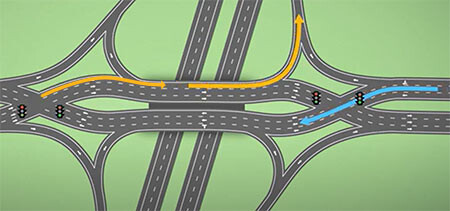A Diverging Diamond Interchange (DDI) is an innovative interchange that moves traffic to the opposite side of the crossroad between the two ramp intersections. Diverging Diamond Interchanges have been shown to have numerous benefits, including:
- Improved safety, especially in busy areas
- Help traffic move more smoothly
- Simpler to build
- Lower cost
They also often occupy less space than other interchange designs requiring loops.
How DDIs Work
Every intersection, including those at ramps, has spots where traffic paths cross, called conflict points. Depending on how much traffic there is, these intersections are usually controlled by:
- stop signs,
- traffic signals (aka stop lights),
- or roundabouts.
Diverging diamond interchanges move traffic from one side of the interchange crossroad to the other, and then back again. This eliminates the left turns that must cross oncoming traffic. By redirecting traffic to the left side of the road, the DDI allows for smoother, uninterrupted traffic flow, reducing delays and keeping vehicles moving more consistently.
See example: I-35 & 1st Street - Ankeny, IA
Why DDIs Work
When a traffic signal is used, it operates in several steps called phases.
The left turn phase is especially important for safety. At busy intersections, a green arrow is usually needed to make left turns safe.
- Left turns from the interchange crossroad onto the entrance ramp.
- Straight-through traffic on the crossroad in both directions.
- Traffic exiting the ramps.
| Conventional Ramp Intersection Left-turn Signal Phasing | ||
|---|---|---|
| Protected Left Turn Movement | Through Movement (with possible Permissive Left Turn) | Exit Ramp Movements |
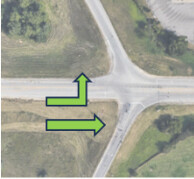
|

|
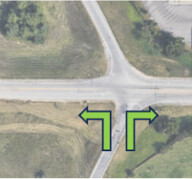
|
The ramp intersection traffic signals at a Diverging Diamond Interchange (DDI) work differently than most ramp intersections. Instead of the usual setup with three phases for each cycle at the ramp intersection traffic signal, a DDI shifts the traffic lanes to the opposite side of the road. This change allows for free right turns and left turns from the crossroad to the entrance ramps.
For example, when making a left turn onto a ramp, you do it before reaching the intersection, so you don’t have to wait for a green arrow or for oncoming traffic to pass.
This setup simplifies the traffic signals with only two phases, helping cars move more smoothly in and out of the ramps. Although it might initially seem strange, clear signs, signals, and road markings will guide you safely through it.
Where Iowa DOT is Constructing DDIs
Since the first one opened in Springfield, Missouri, in 2009, over 200 Diverging Diamond Interchanges (DDIs) have been built across the U.S.
In Iowa, the DOT works with city and county partners to improve interchanges. As of August 2024, Iowa has three DDIs, with one more under construction and three others in the planning and design stages.
| Location | City/County | Opened | More Info |
|---|---|---|---|
| I-80 & Grand Prairie Parkway | Waukee – Dallas County | 2015 | Google Maps |
| I-35 & E 1st Street | Ankeny – Polk County | 2020 | Google Maps |
| I-380 & Tower Terrace Road | Hiawatha – Linn County | 2023 | Google Maps |
| I-80 & 1st Ave | Coralville – Johnson County | 2023-2024 | Google Maps Website |
| I-380 & Boyson Road | Hiawatha – Linn County | 2025-2026 | Google Maps |
| I-380 & Wright Brothers Boulevard | Linn County | 2026-2027 | Google Maps |
| I-80/35 & Hickman Road | Clive/Urbandale – Polk County | 2027-2028 | Google Maps Website City Video |
How A Freeway Interchange Type is Selected
- At a freeway interchange, a major highway crosses over or under a lower-priority crossroad. The traffic getting on or off the freeway meets the crossroad at the ramp intersections.
- After looking at different interchange options, including how much traffic there is now and in the future, the cost to build, the need for land, how well traffic moves, and safety - a decision is made on which type to use. This process is usually explained in an Interchange Justification Report (IJR) and often includes more detailed environmental studies, usually called the National Environmental Policy Act (NEPA) process.
In Iowa, the most common interchange designs are diamond interchanges, cloverleafs (full and partial), and folded diamonds, which combine elements of both (see the diagrams below). These designs are effective in many locations. Depending on where they are, most of these interchanges can have traffic lights or roundabouts where the ramps meet the crossroad.
| Conventional Interchange Types | ||
|---|---|---|
| Diamond Interchange (with stop signs or signals) | Partial Cloverleaf Interchange | Folded Diamond Interchange |
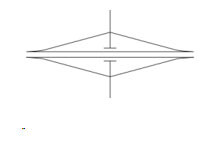
|

|
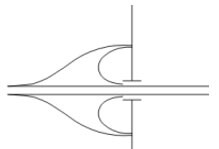
|
At some higher traffic volume and high growth locations, other innovative interchange designs have shown increased safety and reduced delay. The most common of these are diverging diamond interchanges (DDIs), roundabout interchanges, and single-point urban interchanges (SPUI)
| Innovative Interchange Types | ||
|---|---|---|
| Diverging Diamond Interchange (DDI) | Roundabout Interchange | Single-Point Urban Interchange (SPUI) |
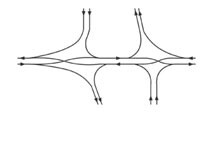
|

|

|
